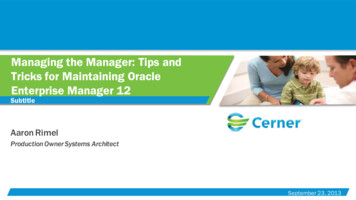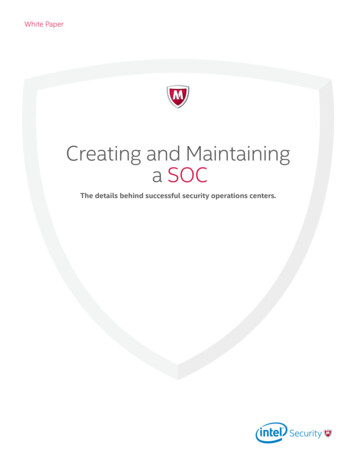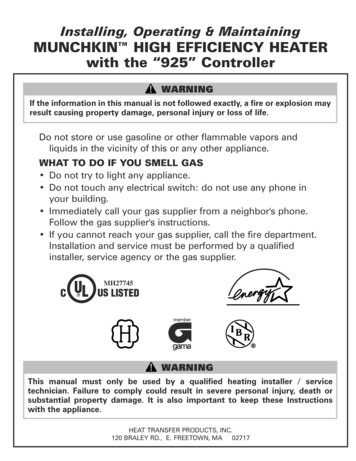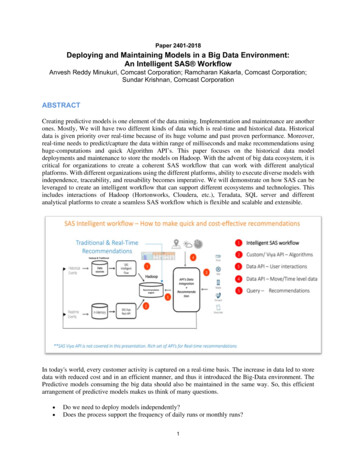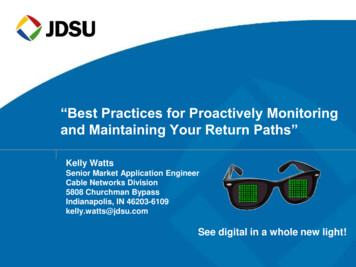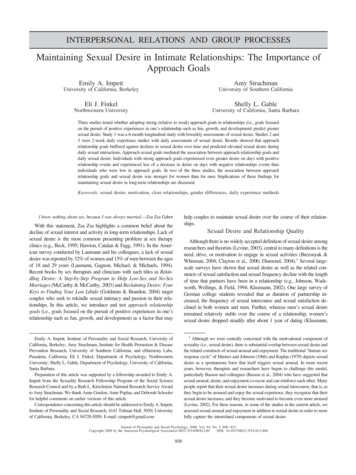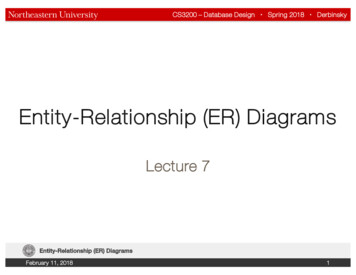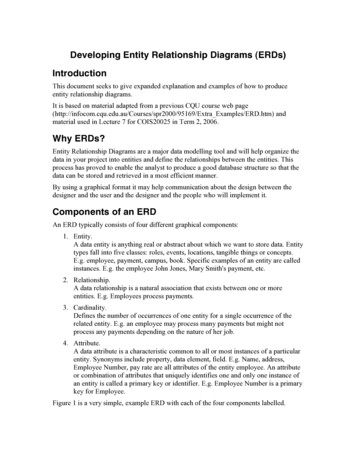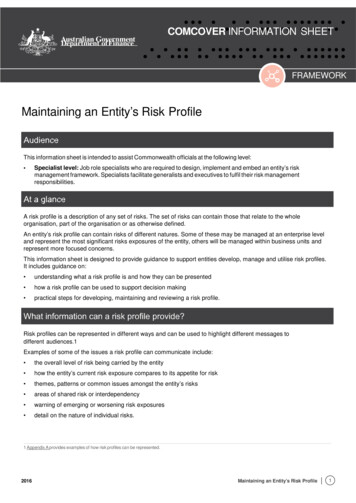
Transcription
COMCOVER INFORMATION SHEETDepartment of FinanceFRAMEWORKMaintaining an Entity’s Risk ProfileThis information sheet is intended to assist Commonwealth officials at the following level: Specialist level: Job role specialists who are required to design, implement and embed an entity’s riskmanagement framework. Specialists facilitate generalists and executives to fulfil their risk managementresponsibilities.A risk profile is a description of any set of risks. The set of risks can contain those that relate to the wholeorganisation, part of the organisation or as otherwise defined.An entity’s risk profile can contain risks of different natures. Some of these may be managed at an enterprise leveland represent the most significant risks exposures of the entity, others will be managed within business units andrepresent more focused concerns.This information sheet is designed to provide guidance to support entities develop, manage and utilise risk profiles.It includes guidance on: understanding what a risk profile is and how they can be presented how a risk profile can be used to support decision making practical steps for developing, maintaining and reviewing a risk profile.Risk profiles can be represented in different ways and can be used to highlight different messages todifferent audiences.1Examples of some of the issues a risk profile can communicate include: the overall level of risk being carried by the entity how the entity’s current risk exposure compares to its appetite for risk themes, patterns or common issues amongst the entity’s risks areas of shared risk or interdependency warning of emerging or worsening risk exposures detail on the nature of individual risks.1 Appendix A provides examples of how risk profiles can be represented.2016Maintaining an Entity’s Risk Profile1
The underlying data for an entity’s risk profile is commonly contained in one or more risk registers. Typically, eachrisk register contains information in a spreadsheet or database format. For each risk, this might include the riskevent, its category, the inherent risk rating, sources or causal factors, links to risks in other registers, controls andcontrol effectiveness rating, and residual risk rating. Each entity will present this differently though in a format thatsuits their organisation. An illustrative example of a simple risk register is provided at Appendix A.As a typical risk register contains a lot of detail, it is not always the best way of presenting risk information to seniordecision makers. A risk profile can be an effective way of summarising the information held in the entity’s riskregisters in an easy to understand format.Consider the audience and their information needs when portraying the risk profile. Four examples of different riskprofile representations are provided at Appendix A. They include a simple risk register format, a ‘heat map’ or riskseverity matrix2, a graph of inherent risk against the effectiveness of current controls, and a comparison of riskseverity against risk tolerance.Ultimately, the accountable authority is responsible for ensuring the appropriate management of an entity’s riskprofile. In practice, the manager/s of the entity’s risk registers, and therefore the profile, will vary depending on thesize, nature and complexity of the entity. The table below highlights how risk profile maintenance can be devolved,centralised or managed in a hybrid model.DevolvedCentralisedHybridIn a devolved model, businessunits maintain their own risk profilesand communicate risk informationindependently to the executivecommittee. Very little centralisedsupport to risk profile development,analysis or maintenance isprovided.In a centralised model, risk isidentified and assessed and thenprovided to a centralised functionwho maintain risk profiles acrossthe entity. Risk recording, profilemaintenance and analysis, andcontrol monitoring is centrallycoordinated.In a hybrid model risks areidentified, assessed and managedto in all areas of the organisation.However a central risk functionsupports the maintenance of thedevolved risk profiles andcoordinates reporting and analysisinformation as well.A devolved model can be beneficialwhere business units are managedwith a high degree of autonomy.It provides for flexibility and suitsa model of decentralised businessdecision making.The benefits of centralised modelincludes economies of scale,minimal duplication of work andwell-defined reporting lines.It also promotes consistencyand suits entities where mostdecision making is made at theenterprise level.The Hybrid model suits wherebusiness units are required to beaccountable for managing theirrisks and where decision makingrequires a degree of collaboration.2 This representation is often referred to as a ‘heat map’ as the severity of the risk is traditionally illustrated by colour shading with ‘hot’ red colours indicatingsevere risks, and ‘cool’ green colours indicating less severe risks.2016Maintaining an Entity’s Risk Profile2
Better informed decision making and corporate planningA key purpose of a risk profile is to support effective decision making in circumstances of uncertainty.By clearly highlighting where key risk exposures exist, senior decision makers can work to manage theseand avoid action which would drive the risk outside of acceptable tolerances.Improved ability to anticipate change, emerging risk and disruption to operationsA risk profile can support the consideration of emerging and future risk as well as current exposures so thatcontingency plans can be developed where required.A disciplined approach to risk profile maintenance includes an ongoing process to identify new or emergingrisks and analyse the threats and opportunities they may represent. This process helps the entity to: understand the likely effectiveness of existing strategies and controls in mitigating emerging risk andoptimising opportunity understand how new risk changes the overall exposure of the entity understand the impact that the changed risk profile could have on stakeholders and shared risks anticipate change and disruption to operationsUnderstanding risk exposure compared to risk appetiteA good representation of an entity’s risk profile will support senior officials to understand whether the entityis holding too much, too little, or just enough risk. Where an entity has a well defined risk appetite, this can berepresented within the risk profile. The risk profile can be used to clearly highlight where activities, programs orbusiness units are operating outside defined risk tolerance thresholds.The following is one approach to developing, analysing, maintaining and communicating a risk profile.The actual process used may be tailored to the specific needs of each entity or circumstance.f2016tMaintaining an Entity’s Risk Profile3
Step 1 – Develop the risk profileA first step is to develop the risk profile by conducting a risk assessment and capture the outcome in a risk register.Depending on the size of the entity, its risk profile may be developed from one or many individual risk assessments.When developing the risk profile: assess risk with both a short and long-term focus. This enables the subsequent risk profile to inform bothimmediate action and longer term planning seek input from stakeholders and relevant subject matter experts who best understand the risks develop the risk profile in accordance with the relevant risk management framework and ensure consistent andcorrect use of risk terminology and categories.Although it differs between entities, the corporate planning process will commonly link the entity’s corporate andbusiness unit plans to its objectives. These objectives form a crucial starting point for any risk assessment in theentity, and a key focus of the entity risk profile is to manage the uncertainty around their achievement.Step 2 – Analyse the risk profile for common themes and systemic issuesJust as individual risks are analysed to fully understand them, the risk profile can be analysed to identify key,common or systemic issues between and amongst the risks. Understanding these can focus attention on wherethe most effective change can be made.Examples of patterns, themes and issues to look for include: patterns in the difference between inherent vs residual risk. The extent and consistency of difference will give anindication of the effectiveness of the entity’s control framework common causal factors, where a small number of contributing issues are relevant to a larger number of risks.These may suggest priority opportunities for treatment linkages between risks in different profiles. This can help understand interdependencies, relationships and theopportunity for cascading failures concentrations of severe risk in certain categories may indicate areas of particular vulnerability for review.For example, if an otherwise robust entity is managing a number of severe risks within one category it mayindicate attention needs to be paid to this area.Step 3 – Continuous review and refreshAny risk profile needs continual maintenance. In part, this determines if there have been any changes to the riskprofile caused by changes to the internal or external context. Reviewing the risk profile can assist in ensuring that: assumptions about risks remain valid and the external and internal context in which the risks were assessedremain valid results of risk assessment are in line with actual experience risk controls are being maintained and assured, and that proposed treatments are being implemented as required assumptions around the interrelationships and linkages between risks at all levels at the organisation and theimpact of change in one risk on another, remains valid.The monitoring and reporting cycles of corporate plans and risk profiles can be aligned to create synergies betweenthe two activities. The monitoring and review process needs to keep pace with changing priorities and the refresh ofthe corporate plan is a good opportunity to refresh the relevant risk profiles in their entirety.Practical strategies that can be used to guide the review of an entity’s risk profile include: Having a relevant risk owner or steward present an analysis of a small number of risks with a focus on keychanges or concerns. Over time, this will result in a rolling program of review ofthe risk profile. Avoid the practice of reviewing every risk in a risk profile in a single meeting or session.Doing so can lead to compliance behaviours and skipping over the risks that require the most attention. Periodically recreate the risk profile from a ‘clean sheet’. Occasionally starting from scratch and performing afresh risk assessment and then reconciling the results with the existing profile is a great way to ensure you don’tbecome fixated on simply refining existing risks.2016Maintaining an Entity’s Risk Profile4
Establish escalation mechanisms to ensure that risks in the entity risk profile are being managed at the right level. Ensure those responsible for designing or implementing new policies or programs first review relevant elementsof the risk profile to ensure that they understand whether risks will be created or modified and that controlstrategies remain appropriate and effective. Consider risk monitoring information already available such as audit reports, quality assuranceactivities, and the results of key performance indicators.Step 4 – Communicate the risk profileEnsure that the risk profile is communicated to the right people at the right time in an appropriate format.Some considerations when communicating the risk profile include: seeking feedback from executive reviewers and stakeholders on how often and to whom risks are to be reported establishing well understood risk escalation and aggregation protocols so that unacceptable risks can be quicklyconveyed to the appropriate level of management and that the nature of the risk is clear tailoring the presentation of the risk profile to its audience and consider their risk management maturity using colour to highlight key issues and areas of concern, or focus the audience’s attention on the risks orconcerns that most warrant discussion.For further information on risk communication refer to the Comcover Information Sheet Communicating Risk.2016Maintaining an Entity’s Risk Profile5
Example 1. Traditional Risk RegisterAlthough they vary in scale and complexity, a simple risk register may typically contain the following elementsfor each risk: risk ID or unique identifier description of the risk – its cause, the risk event, and key outcome should it be realised a risk category or group or family sources or causal factors relevant to the risk the likelihood of the risk occurring the potential impact or consequence should the risk be realised control measures currently in place and an assessment of their effectiveness an assessment of how the risk is changing or trending and how quickly it could be realised an assessment of risk tolerability, or how the risk compares to relevant elements of the entity’s risk appetite treatments (proposed controls) to be implemented to improve the management of the risk, if required owner or steward of the EM34.57.5S3.4EMRisk of inadequateplanning to avoid futuresignificant adverseenvironmental impacts2.346.3M1.9Fraud or improper actions2.93.16L2.4LikelihoodConsequenceThe table below is an illustrative example of a simple risk register.3Failure to comply with regulatoryand statutory requirements2.9StakeholderManagementSignificant and ongoing adversestakeholder reaction4.Workplace Health& SafetyWorkplace Health and Safetyis compromised5.Environment &Sustainability6.FinanceRisk CategoryRisk Description1.StakeholderManagementFailure to agree outcomes ormaintain a healthyrelationship and consult withStakeholder X2.Legal & EL3 These representations are examples only and not
Maintaining an Entity’s Risk Profile . This information sheet is intended to assist Commonwealth officials at the following level: Specialist level: Job role specialists who are required to design, implement and embed an entity’s risk management framework. Specialists facilitate generalists and executives to fulfil their risk management responsibilities. A risk profile is a description .
